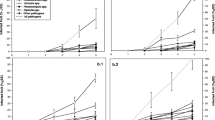Summary
Seven types of fruits, namely mangoes, apples, peaches, pears, oranges pomegranates and grapes have been studied for fungal decay in storage and its relation to shop (local storage places) atmosphere and, in the case of mangoes orchard atmosphere has been elucidated. Mango has received particular attention as it is the staple fruit of the United Provinces.
A number of fungi have been obtained from the tissues of diseased fruits. These areAspergillus nigei, Aspergillus nidulans, Aspergillus variecolour, Aspergillus fumigatus, Aspergillus Candidus, Acrothecium penniseti,Alternaria sp.,Colletotrichum capsci, Colletotrichum sp.,Penicillium atramentosum, andRhizopus arrhizus.
A few fungi have also been isolated as ‘latent infections’ from apparently healthy fruits. Mangoes have yieldedAspergillus nidulans andColletotrichum capsci, applesColletotrichum sp., orangesPenicillium fellutanum andAspergillus fumigatus, and grapesRhizopus arrhizus.
There is a definite correlation between the fungi obtained from the fruits and those isolated from the atmosphere of storage places and the surface of diseased fruits. In the case of mangoes a similar correspondence is seen with the fungi from the atmosphere of mango orchards.
Similar content being viewed by others
Literature Consulted
Baker, K. F., and Heald, F. D. “The importance of lenticel infection of apples byPenicillium expansum. State Coll,”Washington Agr. Exp. Sta. Bull., 1932, 264 (original not seen).
Baker, R. E. D. “Studies in the pathogenicity of tropical fungi: II. The occurrence of latent infections in developing fruits,”Ann. Bot., N.S., 1938,2, 919–31.
—, Crowdy, S. H., and Mckee, R. K. “A review of latent infections caused byColletotrichum gloesporioides and allied fungi, ”Trop. Agric., Trinidad, 1940,17, 7, 128–32.
Baker, R. E. D., and Wardlaw, C. M. “Studies in the pathogenicity of tropical fungi: I. On the types of infections encountered in the storage of certain fruits.”Ann. Bot. N.S. 1937,1, 59–65.
Bratley, C. O. “Development of apple scab on stored fruit.”Phytopath., 1933,23, 5.
Dastur, J. F. “Spraying for the ripe rot of the plantain fruit,”Agrie. Journ. India, 1916,11, 142.
Ghatak, P. N. “Investigations on orange rot in storage. I. Orange rot due to two strains ofFusarium moniliforme Sheldon,”Journ. Ind. Bot. Soc., 1938,17, 141–48.
Horne, A. S., and Horne, E. V. “On the spotting of apples in Great Britain,”Ann. Appl. Biol., 1920,7, 183–201.
Simmonds, J. H. “Latent infections in tropical fruits discussed in relation to the part played by species ofGleosporium andColletotrichum,”Proc. Roy. Soc. Qd., 1941,52, 10, 92–120.
Walker, E. A. “Scab of apples in storage,”Trans. Peninsula Hort. Soc., 1940,29, 5, 105–11 (original not seen).
Wardlaw, C. W., Baker, R. E. D., and Crowdy, S. H. “Latent infections in tropical fruits.”Trop. Agric., Trinidad, 1939,16, 12, 275–76.
Wormald, H. “The development of scab in stored apples,”Ann. Rep., East Mailing Res. Station, 1934, 232–35.
Additional information
Communicated by Dr. S. N. Das Gupta,F.A.SC.
Rights and permissions
About this article
Cite this article
Sinha, S. On decay of certain fruits in storage. Proc. Indian Acad. Sci. 24, 198–205 (1946). https://doi.org/10.1007/BF03049674
Received:
Issue Date:
DOI: https://doi.org/10.1007/BF03049674




